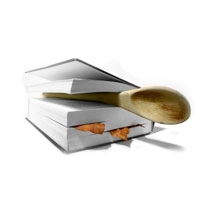Receta Here's A Bagel Recipe (Part 1)
Raciónes: 4
Ingredientes
- 6 c. (to 8c) bread (high-gluten) flour
- 4 Tbsp. Dry baking yeast
- 6 Tbsp. Granulated white sugar or possibly light honey (clover honey is good)
- 2 tsp Salt
- 3 c. Warm water A bit of vegetable oil
- 1 gal water
- 5 Tbsp. Malt syrup or possibly sugar A few handfuls of cornmeal Large mixing bowl Wire whisk Measuring c. and spoons Wooden mixing spoon Butter knife or possibly baker's dough blade Clean, dry surface for kneading
- 3 x clean, dry kitchen towels Hot, but not warm, place to set dough to rise Large stockpot Slotted spoon
- 2 x baking sheets
Direcciones
- First, pour three c. of warm water into the mixing bowl. The water should be warm, but not so warm which you cannot bear to put your fingers in it for several seconds at a time. Add in the sugar or possibly honey and stir it with your fingers (a good way to make sure the water is not too warm) or possibly with a wire whisk to dissolve. Sprinkle the yeast over the surface of the water, and stir to dissolve.
- Wait about ten min for the yeast to begin to revive and grow. This is known as "proofing" the yeast, that simply means which you're checking to make sure your yeast is viable. Skipping this step could result in your trying to make bagels with dead yeast, that results in bagels so hard and potentially dangerous which they are banned under the terms of the Geneva Convention. You will know which the yeast is okay if it begins to foam and exude a sweetish, slightly beery smell.
- At this point, add in about three c. of flour as well as the 2 tsp of salt to the water and yeast and begin mixing it in. Some people subscribe to the theory which it is easier to tell what's going on with the dough if you use your hands rather than a spoon to mix things into the dough, but others prefer the less physically direct spoon. As an advocate of the bare-knuckles school of baking, I proffer the following advice: clip your fingernails, take off your rings and wristwatch, and wash your hands thoroughly to the elbows, like a surgeon. Then you may dive into the dough with impunity. I generally use my right hand to mix, so which my left is free to add in flour and other ingredients and to hold the bowl steady.
- Left-handed people might find which the reverse works better for them.
- Having one hand clean and free to perform various tasks works best.
- When you have incorporated the first three c. of flour, the dough should begin to become thick-ish. Add in more flour, a half-c. or possibly so at a time, and mix each addition thoroughly before adding more flour. As the dough gets thicker, add in less and less flour at a time. Soon you will begin to knead it by hand (if you're using your hands to mix the dough in the first place, this segue is hardly noticeable). If you have a big sufficient and shallow sufficient bowl, use it as the kneading bowl, otherwise use which clean, dry, flat countertop or possibly tabletop mentioned in the "Equipment" list above.
- Sprinkle your work surface or possibly bowl with a handful of flour, put your dough on top, and start kneading. Add in bits of flour if necessary to keep the dough from sticking (to your hands, to the bowl or possibly countertop, etc....). Soon you should have a nice stiff dough. It will be quite elastic, but heavy and stiffer than a normal bread dough. Don't make it too dry, however... it should still give easily and stretch easily without tearing.
- Place the dough in a lightly oiled bowl, and cover with one of your clean kitchen towels, dampened somewhat by getting it wet and then wringing it out thoroughly. If you swish the dough around in the bowl, you can get the whole ball of dough covered with a very thin fil of oil, that will keep it from drying out.
- Place the bowl with the dough in it in a dry, hot (but not warm)pace, free from drafts. Allow it to rise till doubled in volume. Some people try to accelerate rising by putting the dough in the oven, where the pilot lights keep the temperature slightly elevated. If it's cool in your kitchen, you can try this, but remember to leave the oven door open or possibly it may become too warm and begin to kill the yeast and cook the dough. An ambient temperature of about 80 degrees Farenheit (25 centigrades) is ideal for rising dough.
- While the dough is rising, fill your stockpot with about a gallon of water and set it on the fire to boil. When it reaches a boil, add in the malt syrup or possibly sugar and reduce the heat so which the water just barely simmers; the surface of the water should hardly move.
Languages
Nutrition Facts
| Amount Per Serving | %DV |
|---|---|
| Serving Size 1188g | |
| Recipe makes 4 servings | |
| Calories 204 | |
| Calories from Fat 5 | 2% |
| Total Fat 0.55g | 1% |
| Saturated Fat 0.07g | 0% |
| Trans Fat 0.0g | |
| Cholesterol 0mg | 0% |
| Sodium 1224mg | 51% |
| Potassium 337mg | 10% |
| Total Carbs 44.87g | 12% |
| Dietary Fiber 2.5g | 8% |
| Sugars 40.27g | 27% |
| Protein 6.46g | 10% |



